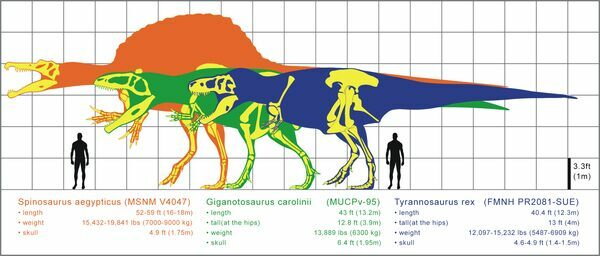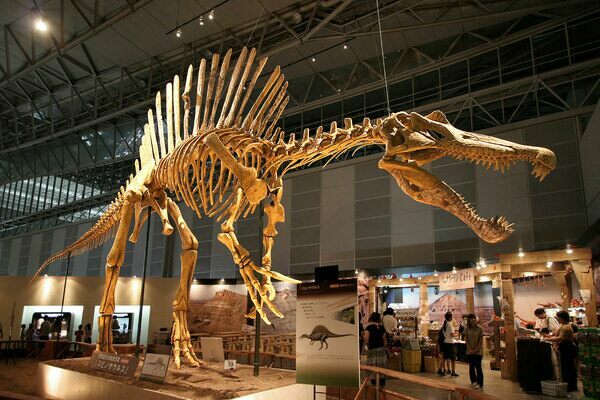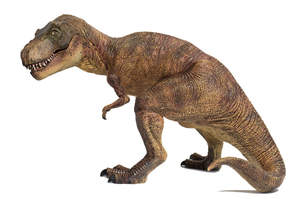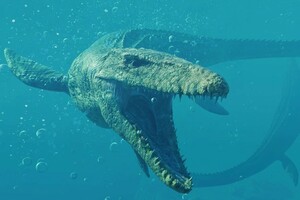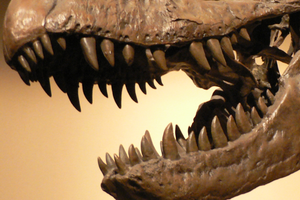Was Spinosaurus Bigger Than T-Rex?
Tyrannosaurus rex has been known for nearly a century for, among other things, being the largest of the theropods, or meat-eating dinosaurs. That is, until recently, when several large theropods cropped up in fossil finds over the past 3 decades. Prior to that, there were few large theropods that even came close to matching the bulk and brawn of the tyrant lizard king. Now however, with the discovery of Giganotosaurus, Carcharodontosaurus, and most of all Spinosaurus, the gap doesn’t seem quite as large.
Spinosaurus was discovered very shortly after Tyrannosaurus was first put on display, however the only known remains at the time were destroyed during World War II, and for years, the only data we had were its initial description, itself based on fragmentary remains. This led scientists to erroneously identify it as a carnosaur more closely related to terrestrial species such as Allosaurus. It was not until much more recently that more complete remains of related species such as Baryonyx gave us a more complete picture of the anatomy of this truly unusual theropod. Even more recent discoveries, such as the unearthing of a partial skull in 2005, have given us a greater insight into the size of this creature.
To put it bluntly, in terms of sheer length and height, Spinosaurus takes the crown handily. With conservative estimates putting Spinosaurus’ length at approximately 50 feet (15 meters), and looser estimates putting it closer to 60 feet (18 meters). Its huge spine puts the animal at an intimidating 20 feet (6.5 meters), though its head height, a more typical measurement point for a theropod’s height, is a shorter 12 feet (3 meters). In contrast T-Rex is estimated to have been 39-42 feet (12-13 meters) long, with a height of 11-13 feet (3-4 meters).
A trickier question comes into play when we discuss mass however. Yes, Spinosaurus was the longer and taller animal, but Tyrannosaurus rex was built like a mountain. Compared to the wealth and abundance of known T.rex specimens across almost every stage of its life history, we have comparatively very little in the way of Spinosaurus specimens, and fewer still with any degree of completeness. This makes the question of how much Spinosaurus weighed extremely difficult to pin down. Estimates of its weight vary as wildly as 4.5 tons to nearly twenty. On top of this, our interpretations of Spinosaurus’s anatomy, physiology, and ecology, all things that would influence its mass, have changed dramatically in the past 20 years, and are still undergoing debate and scrutiny as we speak.
Spinosaurus may not be the most well known theropod, but it certainly has one of the most bizarre histories, both in its discovery and in its anatomy. The earliest material known was discovered in 1912 by Austrian paleontologist Richard Markgraf, then later described in more detail by German paleontologist Ernst Stromer. the dinosaur to be known as Spinosaurus was found in the Bahariya region of western Egypt, giving the species its name, Spinosaurus aegypticus.
Little was known of the animal at the time, and over the next century a variety of competing inferences were made about its appearance and lifestyle. The most striking piece of its anatomy, the sail or “spine” that gives the genus its name, was of particular focus. For years many would place Spinosaurus in and out of various theropod clades, until the 1980’s, when the discovery of the related species Baryonyx fleshed out this unique group of theropods in more detail. It was then understood that the Spinosaurids, as the family would come to be called, had skulls shaped by convergent evolution to be much more crocodilian in appearance. Their heads were long and slender, with conical teeth that made some suggest that the family preferred a piscivorous lifestyle. Spinosaurus itself would prove to be an odd creature, even among its brethren. With the new millennium came new discoveries, and in 2005, a better picture of the skull of Spinosaurus was created with the discovery of new partial remains from the Moroccan Kem Kem Group. Still, it was thought that the postcranial anatomy (the anatomy of the animal behind the skull) was likely similar to its relatives, with no major differences. If this was correct, then it would seem likely that, even were it more slender in build than T. rex, it would at least match it in weight.
In 2014, however, further discovery of partial remains would show us that the anatomy of spinosaurus was anything but typical. The remains, thought to be from a juvenile spinosaurus, preserve a great insight into the greater anatomy of these creatures. Perhaps the most unusual thing about this particular find, however, were the proportionately small hindlimbs. Spinosaurids were known for their long forelimbs with heavy claws, a possible adaptation for a piscivorous lifestyle. Spinosaurus seems to take this a step further, having adapted to have shorter hindlimbs as well. This discovery, led by German-Moroccan paleontologist Nizar Ibrahim, was used to open up a new line of hypothesizing regarding the ecological niche of this strange animal.
Ibrahim argued that the reduced hindlimbs, along with a suite of other adaptations, pointed to a lifestyle of semiaquatic piscivory. Its elongated body, nostrils located medially on the skull, flat feet and claws, and solid, dense bones are all helpful adaptations for an animal leading an aquatic life. In addition, further discovery of tail material published in 2020, also by Ibrahim, show that the long, broad tail was unlike that of terrestrial theropods, possessing a much greater field of lateral motion, and a broad shape built for forward propulsion in an aquatic medium.
So in summary, our interpretation of Spinosaurus has quite rapidly changed in the past few decades. From an image of a croc-headed but otherwise “typical” theropod, to a stocky, squat-legged aquatic fish hunter, Spinosaurus shows us a lot about how interpretation of prehistoric life is always in flux, changing as new data gets unearthed and brought to light. For our discussion, this obviously is going to have a drastic effect on weight estimates.
With all that additional context, the weight estimation being so variable within this genus likely doesn’t seem as extraordinary as before, does it? That being said, most scientists agree on a general estimate placing it around 7 to 8 tons. On average, this would place Spinosaurus in about the same weight range as Tyrannosaurus, which, if we’re keeping tally, makes it the biggest known theropod dinosaur.
Tyrannosaurus rex is quite possibly the most well known dinosaur in the world. Appearing in everything from films, cartoons, children’s toys, and more, the tyrant lizard king is one of the prehistoric world’s most pre-eminent representatives. Discovered in 1902 by Barnum Brown, a paleontologist working for the American Museum of Natural History, it made waves in 1906 when the first mounted skeleton of the animal was set up for public viewing in the museum. At the time, the newspaper The New York Times covered the event with the fanciful headline “THE PRIZE FIGHTER OF ANTIQUITY DISCOVERED AND RESTORED; A Magnificent tyrannosaurus Rex Set up in the Museum of Natural History Here Last of the Great Reptiles and the King of Them All”. Further, they described Tyrannosaurus as “The absolute warlord of the Earth” and “The most formidable fighting animal of which there is any record whatever,”.
This irrevocably cemented the image of the towering theropod predators of the mesozoic era into the eyes of the average person. And for good reason too! For nearly the entirety of the remainder of the twentieth century, no theropod dinosaurs were found that seemed to measure up to the massive beast unearthed in eastern Montana.
Despite its public ubiquity, Tyrannosaurus was something of an oddball of the theropod group. It was the very last of the tyrannosaurs, and the very largest of them all. The tyrannosaurs, however, are just one branch of a larger group called the coelurosaurs. The tyrannosaurs, particularly the later ones like T.rex and Tarbosaurus, were very unusual for coelurosaurs because of their gigantic size. The vast majority of coelurosaurs, including the ancestors of the tyrannosaurs, were small, birdlike dinosaurs with gracile bodies and lithe forms. Other notable and popular members of the coelurosaurs include the dromaeosaurs (“Raptor” dinosaurs), and even birds themselves.
Tyrannosaurus, by contrast, was the end product of a longer evolutionary trend towards gigantism in its family. Throughout the cretaceous period Tyrannosaurs saw their sizes increase at greater rates, with early members of the family scarcely reaching 20 feet, while later members such as Daspletosaurus, Tarbosaurus, and Tyrannosaurus becoming the 35 foot and longer monsters that are more well known. There is histological evidence in the skeletal remains of these animals and their juvenile counterparts of rapid periods of growth occurring at the middle of their lives, their sizes catapulting upward as they passed a decade in age.
Measuring at an average length of 39-42 feet (12-13 meters), a height of 11-13 feet (3-4 meters), and weighing approximately 6-8 tons, Tyrannosaurus was truly
massive, its skull alone being about as long as an average human being is tall (Approx. 5ft./1.75m) Tyrannosaurus was also proportionately much wider and more robust than other known theropods, who in general had more gracile, lighter bodies and proportions. Additionally, several specimens of older individuals have also been found that exceed these average proportions. This suggests, like modern reptiles, that dinosaurs kept growing all the way to the end of their lives. These specimens include the famous “Sue”, the 90% complete skeleton that remains one of the most complete known skeletons of T.rex. Along with Sue, there is also the more recently discovered “Scotty”, unearthed in 2019, who is estimated to be nearly 45 feet (14 meters) and almost 10 tons.
These specimens are certainly not “average” by any stretch, however some argue that they represent a sampling bias in the field of paleontology. Florida state university biologist Gregory Erickson has stated in interview with NPR that “Tyrannosaurus lived fast and died young”, citing the naturally dangerous lifestyle that a terrestrial predator of that size would have faced. Erickson is also one of the authors of the paper formally describing “Scotty”, which in part offers support to previous hypotheses relating to the sampling bias of paleontological remains. These hypotheses suggest that because of the nature of fossilization and the further rarity of human beings locating complete remains, it is possible that our size estimates for fossil organisms may be smaller on average than in actuality. This is still a contested position within the field of paleontology. That being said, if further specimens like “Scotty” and “Sue” were the average, then they would have Spinosaurus beat in the size category, at least by weight.
Now, ignoring the geographic and temporal boundaries between the two species (T.rex lived in North America 65 million years ago, while Spinosaurus lived in North Africa 30 million years earlier), the question of who is mightier remains. The release of the film Jurassic Park III in 2003 brought spinosaurus into the public eye, and for almost two decades since then, monster movie fans and paleontology hobbyists alike have given their two cents on who they think would win in a one-on-one. In the film, the Spinosaurus handily slays its more well-known opponent, becoming the major dino antagonist of the film, but would that be the outcome if such a fantastical scenario played out in real life? For clarity’s sake, the following is pure fun speculation, and should not be taken as a serious scientific analysis.
Spinosaurus was undoubtedly the larger of the two animals, 50 feet long and a sail that made it appear much bigger than it already was. In nature, we typically find that animals don’t go out looking for conflict, and usually will look for other solutions before escalating to full on brawls. Many animals employ scare tactics to try and chase intruders out of their territory. There are exceptions to this of course, wolves for example will sometimes hunt just for the excitement of it, but this is done with a predator-prey dynamic, and not a predator striking out against another, similarly sized predator. If they were to encounter each other, barring other circumstances, it would likely be that the Spinosaurus would employ similar such “scare tactics”.
In life, Spinosaurus would have shared its habitat with a number of large, primarily terrestrial carnivores like Rugops or Carcharodontosaurus, which while not as robust, would have been of a similar size and shape to Tyrannosaurus. As such, it is likely that Spinosaurus would have developed some kind of behavior to deal with cohabitation. Here, I propose that Spinosaurus may have used its large sail as a display to dissuade potential predation from those smaller but more terrestrially adapted predators.
If this were the case, it would likely have used a similar tack if it ever came into contact with some time-displaced Tyrannosaurus. It is likely then, that Tyrannosaurus, being unfamiliar with the display and the animal it was facing, would want to avoid contact with the potential danger, especially one larger than itself, and run away. But this isn’t a “who would make who run away first” argument, now is it. Let's say for the sake of argument, that for whatever reason, be it starvation, territorial behavior, an adrenaline rush, etc., that the Tyrannosaurus would stay and engage the Spinosaurus in a shoreline battle.
Tyrannosaurus rex was a very derived and specialized land predator. Its jaws were huge, broad, and muscular, able to produce the strongest bite known in any terrestrial animal (barring the extinct crocodilians Deinosuchus and Purussaurus), with a force of about 6 tons per square inch of force. Its legs were long but built powerfully, and its body was wide and solidly built.
In contrast, Spinosaurus was very specialized for semi-aquatic life. Its short hind limbs would be a boon in the water, creating less drag for its long, lithe body, but on land both of these adaptations would make a prolonged struggle difficult to maintain. Its jaws were built for grabbing and holding large fish, like the contemporaneous Onchopristis, a kind of saw fish. This makes its bite comparatively ineffective compared to the bone crushing strength of Tyrannosaurus. However, unlike Tyrannosaurus, whose arms were small and specialized for a limited set of behaviors, Spinosaurus’s arms were longer and had a much wider range of motion. It is thought that Spinosaurus’s arms could have held prey items, and it's heavy claws would have made effective slashing weapons.
Habitat would also play an important role in the outcome of this match. Spinosaurus was a semi-aquatic predator, and without the water to retreat into should the need arise, the stocky, squat animal would be without any reliable means of escape or subterfuge. In contrast, while anatomical studies of Tyrannosaurus show that it likely could have swam had the need arisen, it was far from adept at it, and would be quite vulnerable in the water.
Like an old west shootout or a samurai duel, the winner would likely come down to who lands that first, likely devastating blow. If the Tyrannosaurus were able to get its jaws around the Spinosaurus’s neck or leg, it would have caused tremendous bleeding, likely break bones, or even kill the animal outright. But if the spinosaurus were to slash at the Tyrannosaurus with its claws, it may have been able to cause deep gashes, or strike a vital blood vessel, swiftly bringing down the king of the cretaceous. Additionally, if this fight took place on the shore, and the Spinosaurus were able to maneuver the Tyrannosaurus further into the water, it's possible the Spinosaurus could have made like a modern crocodilian, dragging its disoriented aggressor into deeper water to drown it.
Charig, A.J., & Milner, A.C. (1986). Baryonyx, a remarkable new theropod dinosaur. Nature, 324, 359-361.
Taquet, P. (1984). A curious specialisation of the skull of some Cretaceous carnivorous dinosaurs: The long and narrow snout of spinosaurids: Académie des Sciences Comptes Rendus, ser. 217-222
Dal Sasso, Cristiano & Maganuco, Simone & Buffetaut, Eric & Mendez, M.A.. (2005). New information on the skull of the enigmatic theropod Spinosaurus with remarks on its size and affinities. Journal of Vertebrate Paleontology. 25. 10.
Ibrahim, Nizar & Sereno, Paul & Dal Sasso, Cristiano & Maganuco, Simone & Fabbri, Matteo & Martill, David & Zouhri, Samir & Myhrvold, Nathan & Iurino, Dawid. (2014). Semiaquatic adaptations in a giant predatory dinosaur. Science. 345. 10.
Ibrahim, N., Maganuco, S., Dal Sasso, C. et al. Tail-propelled aquatic locomotion in a theropod dinosaur. Nature 581, 67–70 (2020)
Henderson, Donald M. “A buoyancy, balance and stability challenge to the hypothesis of a semi-aquatic Spinosaurus Stromer, 1915 (Dinosauria: Theropoda).” PeerJ vol. 6 e5409. 16 Aug. 2018
Erickson, G., Makovicky, P., Currie, P. et al. Gigantism and comparative life-history parameters of tyrannosaurid dinosaurs. Nature 430, 772–775 (2004) - Persons, W.S., IV, Currie, P.J. and Erickson, G.M. (2020), An Older and Exceptionally Large Adult Specimen of Tyrannosaurus rex. Anat Rec, 303: 656-672.
https://www.nytimes.com/1906/12/30/archives/the-prize-fighter-of-antiquity-discovered-and-restored-a.html
https://www.npr.org/templates/story/story.php?storyId=3846647
Spinosaurus was discovered very shortly after Tyrannosaurus was first put on display, however the only known remains at the time were destroyed during World War II, and for years, the only data we had were its initial description, itself based on fragmentary remains. This led scientists to erroneously identify it as a carnosaur more closely related to terrestrial species such as Allosaurus. It was not until much more recently that more complete remains of related species such as Baryonyx gave us a more complete picture of the anatomy of this truly unusual theropod. Even more recent discoveries, such as the unearthing of a partial skull in 2005, have given us a greater insight into the size of this creature.
To put it bluntly, in terms of sheer length and height, Spinosaurus takes the crown handily. With conservative estimates putting Spinosaurus’ length at approximately 50 feet (15 meters), and looser estimates putting it closer to 60 feet (18 meters). Its huge spine puts the animal at an intimidating 20 feet (6.5 meters), though its head height, a more typical measurement point for a theropod’s height, is a shorter 12 feet (3 meters). In contrast T-Rex is estimated to have been 39-42 feet (12-13 meters) long, with a height of 11-13 feet (3-4 meters).
A trickier question comes into play when we discuss mass however. Yes, Spinosaurus was the longer and taller animal, but Tyrannosaurus rex was built like a mountain. Compared to the wealth and abundance of known T.rex specimens across almost every stage of its life history, we have comparatively very little in the way of Spinosaurus specimens, and fewer still with any degree of completeness. This makes the question of how much Spinosaurus weighed extremely difficult to pin down. Estimates of its weight vary as wildly as 4.5 tons to nearly twenty. On top of this, our interpretations of Spinosaurus’s anatomy, physiology, and ecology, all things that would influence its mass, have changed dramatically in the past 20 years, and are still undergoing debate and scrutiny as we speak.
In This Corner, Spinosaurus!
Spinosaurus may not be the most well known theropod, but it certainly has one of the most bizarre histories, both in its discovery and in its anatomy. The earliest material known was discovered in 1912 by Austrian paleontologist Richard Markgraf, then later described in more detail by German paleontologist Ernst Stromer. the dinosaur to be known as Spinosaurus was found in the Bahariya region of western Egypt, giving the species its name, Spinosaurus aegypticus.
Little was known of the animal at the time, and over the next century a variety of competing inferences were made about its appearance and lifestyle. The most striking piece of its anatomy, the sail or “spine” that gives the genus its name, was of particular focus. For years many would place Spinosaurus in and out of various theropod clades, until the 1980’s, when the discovery of the related species Baryonyx fleshed out this unique group of theropods in more detail. It was then understood that the Spinosaurids, as the family would come to be called, had skulls shaped by convergent evolution to be much more crocodilian in appearance. Their heads were long and slender, with conical teeth that made some suggest that the family preferred a piscivorous lifestyle. Spinosaurus itself would prove to be an odd creature, even among its brethren. With the new millennium came new discoveries, and in 2005, a better picture of the skull of Spinosaurus was created with the discovery of new partial remains from the Moroccan Kem Kem Group. Still, it was thought that the postcranial anatomy (the anatomy of the animal behind the skull) was likely similar to its relatives, with no major differences. If this was correct, then it would seem likely that, even were it more slender in build than T. rex, it would at least match it in weight.
In 2014, however, further discovery of partial remains would show us that the anatomy of spinosaurus was anything but typical. The remains, thought to be from a juvenile spinosaurus, preserve a great insight into the greater anatomy of these creatures. Perhaps the most unusual thing about this particular find, however, were the proportionately small hindlimbs. Spinosaurids were known for their long forelimbs with heavy claws, a possible adaptation for a piscivorous lifestyle. Spinosaurus seems to take this a step further, having adapted to have shorter hindlimbs as well. This discovery, led by German-Moroccan paleontologist Nizar Ibrahim, was used to open up a new line of hypothesizing regarding the ecological niche of this strange animal.
Ibrahim argued that the reduced hindlimbs, along with a suite of other adaptations, pointed to a lifestyle of semiaquatic piscivory. Its elongated body, nostrils located medially on the skull, flat feet and claws, and solid, dense bones are all helpful adaptations for an animal leading an aquatic life. In addition, further discovery of tail material published in 2020, also by Ibrahim, show that the long, broad tail was unlike that of terrestrial theropods, possessing a much greater field of lateral motion, and a broad shape built for forward propulsion in an aquatic medium.
So in summary, our interpretation of Spinosaurus has quite rapidly changed in the past few decades. From an image of a croc-headed but otherwise “typical” theropod, to a stocky, squat-legged aquatic fish hunter, Spinosaurus shows us a lot about how interpretation of prehistoric life is always in flux, changing as new data gets unearthed and brought to light. For our discussion, this obviously is going to have a drastic effect on weight estimates.
With all that additional context, the weight estimation being so variable within this genus likely doesn’t seem as extraordinary as before, does it? That being said, most scientists agree on a general estimate placing it around 7 to 8 tons. On average, this would place Spinosaurus in about the same weight range as Tyrannosaurus, which, if we’re keeping tally, makes it the biggest known theropod dinosaur.
In This Corner, T-Rex!
Tyrannosaurus rex is quite possibly the most well known dinosaur in the world. Appearing in everything from films, cartoons, children’s toys, and more, the tyrant lizard king is one of the prehistoric world’s most pre-eminent representatives. Discovered in 1902 by Barnum Brown, a paleontologist working for the American Museum of Natural History, it made waves in 1906 when the first mounted skeleton of the animal was set up for public viewing in the museum. At the time, the newspaper The New York Times covered the event with the fanciful headline “THE PRIZE FIGHTER OF ANTIQUITY DISCOVERED AND RESTORED; A Magnificent tyrannosaurus Rex Set up in the Museum of Natural History Here Last of the Great Reptiles and the King of Them All”. Further, they described Tyrannosaurus as “The absolute warlord of the Earth” and “The most formidable fighting animal of which there is any record whatever,”.
This irrevocably cemented the image of the towering theropod predators of the mesozoic era into the eyes of the average person. And for good reason too! For nearly the entirety of the remainder of the twentieth century, no theropod dinosaurs were found that seemed to measure up to the massive beast unearthed in eastern Montana.
Despite its public ubiquity, Tyrannosaurus was something of an oddball of the theropod group. It was the very last of the tyrannosaurs, and the very largest of them all. The tyrannosaurs, however, are just one branch of a larger group called the coelurosaurs. The tyrannosaurs, particularly the later ones like T.rex and Tarbosaurus, were very unusual for coelurosaurs because of their gigantic size. The vast majority of coelurosaurs, including the ancestors of the tyrannosaurs, were small, birdlike dinosaurs with gracile bodies and lithe forms. Other notable and popular members of the coelurosaurs include the dromaeosaurs (“Raptor” dinosaurs), and even birds themselves.
Tyrannosaurus, by contrast, was the end product of a longer evolutionary trend towards gigantism in its family. Throughout the cretaceous period Tyrannosaurs saw their sizes increase at greater rates, with early members of the family scarcely reaching 20 feet, while later members such as Daspletosaurus, Tarbosaurus, and Tyrannosaurus becoming the 35 foot and longer monsters that are more well known. There is histological evidence in the skeletal remains of these animals and their juvenile counterparts of rapid periods of growth occurring at the middle of their lives, their sizes catapulting upward as they passed a decade in age.
Measuring at an average length of 39-42 feet (12-13 meters), a height of 11-13 feet (3-4 meters), and weighing approximately 6-8 tons, Tyrannosaurus was truly
massive, its skull alone being about as long as an average human being is tall (Approx. 5ft./1.75m) Tyrannosaurus was also proportionately much wider and more robust than other known theropods, who in general had more gracile, lighter bodies and proportions. Additionally, several specimens of older individuals have also been found that exceed these average proportions. This suggests, like modern reptiles, that dinosaurs kept growing all the way to the end of their lives. These specimens include the famous “Sue”, the 90% complete skeleton that remains one of the most complete known skeletons of T.rex. Along with Sue, there is also the more recently discovered “Scotty”, unearthed in 2019, who is estimated to be nearly 45 feet (14 meters) and almost 10 tons.
These specimens are certainly not “average” by any stretch, however some argue that they represent a sampling bias in the field of paleontology. Florida state university biologist Gregory Erickson has stated in interview with NPR that “Tyrannosaurus lived fast and died young”, citing the naturally dangerous lifestyle that a terrestrial predator of that size would have faced. Erickson is also one of the authors of the paper formally describing “Scotty”, which in part offers support to previous hypotheses relating to the sampling bias of paleontological remains. These hypotheses suggest that because of the nature of fossilization and the further rarity of human beings locating complete remains, it is possible that our size estimates for fossil organisms may be smaller on average than in actuality. This is still a contested position within the field of paleontology. That being said, if further specimens like “Scotty” and “Sue” were the average, then they would have Spinosaurus beat in the size category, at least by weight.
Just For Fun, Spinosaurus Vs T-Rex?
Now, ignoring the geographic and temporal boundaries between the two species (T.rex lived in North America 65 million years ago, while Spinosaurus lived in North Africa 30 million years earlier), the question of who is mightier remains. The release of the film Jurassic Park III in 2003 brought spinosaurus into the public eye, and for almost two decades since then, monster movie fans and paleontology hobbyists alike have given their two cents on who they think would win in a one-on-one. In the film, the Spinosaurus handily slays its more well-known opponent, becoming the major dino antagonist of the film, but would that be the outcome if such a fantastical scenario played out in real life? For clarity’s sake, the following is pure fun speculation, and should not be taken as a serious scientific analysis.
Spinosaurus was undoubtedly the larger of the two animals, 50 feet long and a sail that made it appear much bigger than it already was. In nature, we typically find that animals don’t go out looking for conflict, and usually will look for other solutions before escalating to full on brawls. Many animals employ scare tactics to try and chase intruders out of their territory. There are exceptions to this of course, wolves for example will sometimes hunt just for the excitement of it, but this is done with a predator-prey dynamic, and not a predator striking out against another, similarly sized predator. If they were to encounter each other, barring other circumstances, it would likely be that the Spinosaurus would employ similar such “scare tactics”.
In life, Spinosaurus would have shared its habitat with a number of large, primarily terrestrial carnivores like Rugops or Carcharodontosaurus, which while not as robust, would have been of a similar size and shape to Tyrannosaurus. As such, it is likely that Spinosaurus would have developed some kind of behavior to deal with cohabitation. Here, I propose that Spinosaurus may have used its large sail as a display to dissuade potential predation from those smaller but more terrestrially adapted predators.
If this were the case, it would likely have used a similar tack if it ever came into contact with some time-displaced Tyrannosaurus. It is likely then, that Tyrannosaurus, being unfamiliar with the display and the animal it was facing, would want to avoid contact with the potential danger, especially one larger than itself, and run away. But this isn’t a “who would make who run away first” argument, now is it. Let's say for the sake of argument, that for whatever reason, be it starvation, territorial behavior, an adrenaline rush, etc., that the Tyrannosaurus would stay and engage the Spinosaurus in a shoreline battle.
Tyrannosaurus rex was a very derived and specialized land predator. Its jaws were huge, broad, and muscular, able to produce the strongest bite known in any terrestrial animal (barring the extinct crocodilians Deinosuchus and Purussaurus), with a force of about 6 tons per square inch of force. Its legs were long but built powerfully, and its body was wide and solidly built.
In contrast, Spinosaurus was very specialized for semi-aquatic life. Its short hind limbs would be a boon in the water, creating less drag for its long, lithe body, but on land both of these adaptations would make a prolonged struggle difficult to maintain. Its jaws were built for grabbing and holding large fish, like the contemporaneous Onchopristis, a kind of saw fish. This makes its bite comparatively ineffective compared to the bone crushing strength of Tyrannosaurus. However, unlike Tyrannosaurus, whose arms were small and specialized for a limited set of behaviors, Spinosaurus’s arms were longer and had a much wider range of motion. It is thought that Spinosaurus’s arms could have held prey items, and it's heavy claws would have made effective slashing weapons.
Habitat would also play an important role in the outcome of this match. Spinosaurus was a semi-aquatic predator, and without the water to retreat into should the need arise, the stocky, squat animal would be without any reliable means of escape or subterfuge. In contrast, while anatomical studies of Tyrannosaurus show that it likely could have swam had the need arisen, it was far from adept at it, and would be quite vulnerable in the water.
Like an old west shootout or a samurai duel, the winner would likely come down to who lands that first, likely devastating blow. If the Tyrannosaurus were able to get its jaws around the Spinosaurus’s neck or leg, it would have caused tremendous bleeding, likely break bones, or even kill the animal outright. But if the spinosaurus were to slash at the Tyrannosaurus with its claws, it may have been able to cause deep gashes, or strike a vital blood vessel, swiftly bringing down the king of the cretaceous. Additionally, if this fight took place on the shore, and the Spinosaurus were able to maneuver the Tyrannosaurus further into the water, it's possible the Spinosaurus could have made like a modern crocodilian, dragging its disoriented aggressor into deeper water to drown it.
 Reviews
Reviews
